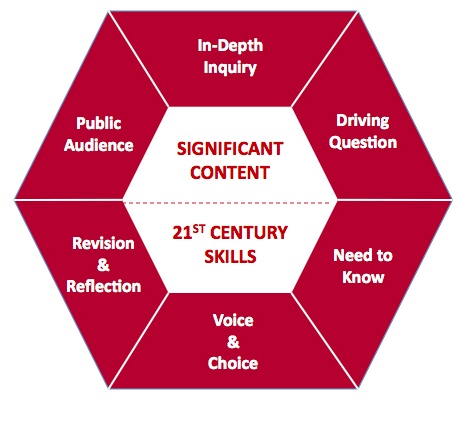|
Problem Based Learning for Pre-Service Teachers A.Aranguiz Teaching Pre-Service Teachers How to Design, Implement and Assess PBL
|

From the Buck Institute for Education
|
 From the Buck Institute for Education |
|
> Observe, and emulate Master Teachers' Classroom Management Skills during PBL process ➢ Teach students how to ask and answer questions ➢ Model and practice generating Driving Questions ➢ Participate in an authentic PBL project in the pre-service class, role playing the roles of both teacher and student to gain insight about the process ➢ Observe other classrooms where PBL is being implemented effectively ➢ Seek out a PBL teacher expert who is willing to mentor and share ➢ Believe that PBL is possible for ALL students regardless of grade or ability level ➢ Change mindset that learning must be passive and teacher-centered ➢ Be flexible ➢ Be flexible and creative with the CCSS; scaffold and embed competencies throughout the PBL activities ➢ Develop a thick skin and strategize for dealing with anti-PBL culture from administrators, peers, parents or even students ➢ Strategize a back up plan to deal with technology issues ➢ Design a PBL project with and without tech ➢ Move forward with PBL regardless of tech issues and find alternatives ➢ Strategize for those what if moments that threaten to sabotage PBL process ➢ Seek a teacher partner so everyone can collaborate locally, nationally or globally ➢ Assess formatively and summatively ➢ Teach students to self-assess and peer-assess ➢ Provide students with specific feedback ➢ Enlist parent assistance ➢ Reflect often throughout the PBL process ➢ Learn how to design quality rubrics and checklists ➢ Search for print and non print sources which inspire PBL ➢ Seek out organizations and companies which offer PBL opportunities, e.g. C-SPAN StudentCam ➢ Join a PLN on Twitter focused on #PBL ➢ Stay organized ➢ Use sites like Mentor Mob, Live Binders, or Pinterest to keep PBL resources and ideas organized ➢ Allow students choice in what they learn and what content or product they create ➢ Design PBL projects that are interdisciplinary ➢ Provide students with a PBL premiere to showcase their PBL project locally, nationally or globally ➢ Send out a press release about students’ PBL success ➢ Invite community stakeholders to PBL premiere ➢ Teach students how to seek out experts in the field to use in their PBL ➢ Expect noise and organized chaos; determine coping skills for dealing with challenges of a PBL environment ➢ Expect to be very busy circulating classroom, conferring with students from beginning of day to end ➢ Be available before and after school, or during lunch so students can come in and work on their PBL projects, and confer with you ➢ Allow students independence; do not give them answers or provide research for them ➢ Teach students how to research and cite sources ➢ Have fun, learn along with the students, and enjoy those “aha” moments when together everyone discovers how much fun it is to learn! |
Links:
|